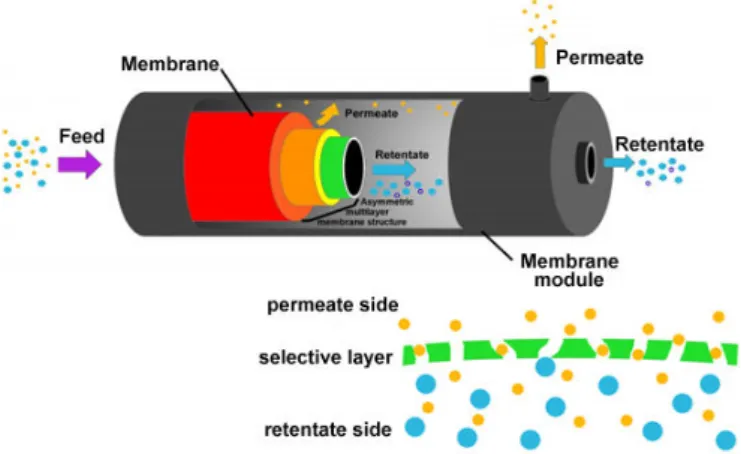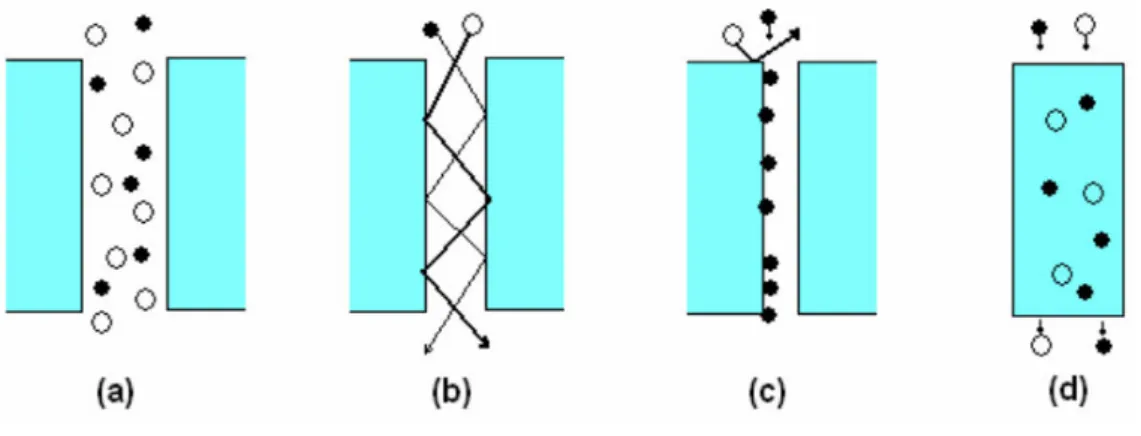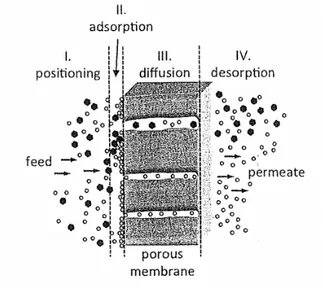GAS TRANSPORT THROUGH
POROUS MEMBRANES
D. DE MEIS Dipartimento Fusione e Tecnologie per la Sicurezza Nucleare Divisione Fisica della Fusione Laboratorio Sorgenti,Antenne e Diagnostica Centro Ricerche Frascati,Roma
RT/2017/7/ENEA
ITALIAN NATIONAL AGENCY FOR NEW TECHNOLOGIES, ENERGY AND SUSTAINABLE ECONOMIC DEVELOPMENT
D. DE MEIS Dipartimento Fusione e Tecnologie per la Sicurezza Nucleare Divisione Fisica della Fusione Laboratorio Sorgenti, Antenne e Diagnostica Centro Ricerche Frascati, Roma
GAS TRANSPORT THROUGH
POROUS MEMBRANES
RT/2017/7/ENEA
ITALIAN NATIONAL AGENCY FOR NEW TECHNOLOGIES, ENERGY AND SUSTAINABLE ECONOMIC DEVELOPMENT
I rapporti tecnici sono scaricabili in formato pdf dal sito web ENEA alla pagina http://www.enea.it/it/produzione-scientifica/rapporti-tecnici
I contenuti tecnico-scientifici dei rapporti tecnici dell’ENEA rispecchiano l’opinione degli autori e non necessariamente quella dell’Agenzia
The technical and scientific contents of these reports express the opinion of the authors but not necessarily the opinion of ENEA.
GAS TRANSPORT THROUGH POROUS MEMBRANES D. De Meis
Riassunto
Oggi la filtrazione dei gas con membrane porose è una metodica utilizzata industrialmente come al-ternativa ai metodi di separazione convenzionali quali la distillazione, la centrifugazione e l’estrazione. Per le membrane microporose la permeazione del gas attraverso una membrana è strettamente legata alla porosità, allo spessore complessivo e al diametro medio dei pori.
Sono stati definiti sia i parametri più importanti delle membrane porose che la formula (derivata dalla prima legge di Fick) che mette in relazione il flusso molare alla permeabilità.
Sono stati illustrati tutti i possibili meccanismi di trasporto dei gas nelle membrane porose: Hagen-Pouiselle, Knudsen, surface diffusion, capillary condensation and molecular sieving. È stato anche de-scritto il modello di trasporto in parallelo in cui la permeabilità è la somma dei meccanismi sopra descritti.
Infine è stato mostrato il caso relativo a membrane con pori tra 2 e 50 nm dove hanno luogo il flusso laminare, la diffusione di Knudsen e la diffusione superficiale.
Parole chiave: separazione gassosa, meccanismi di trasporto di gas, membrane porose, diffusione di Knudsen, meccanismo di trasporto di Hagen-Pouiselle
Abstract
Today gas filtration trough porous membranes is used industrially as an alternative to conventional separation methods such as distillation, centrifugation and extraction.
For microporous membranes gas transmission is closely related to porosity, the overall thickness and the mean pore diameter.
The most important parameters of porous membranes as well the formula (derived from Fick’s first law) that relates the molar flux to permeability have been introduced.
All possible gas transport mechanisms in porous membrane have been investigated: Hagen-Pouiselle, Knudsen, surface diffusion, capillary condensation and molecular sieving.
It has been also described the parallel transport model in which the permeability is the sum of the above described mechanisms.
Finally it has been showed the case with pore segment between 2 and 50 nm where laminar flow, Knudsen diffusion and surface diffusion take place.
Keywords: gas separation, gas transport, porous membranes, Knudsen diffusion, Hagen-Pouiselle mechanism
1. Introduction
2. Main parameters in transport through porous media 3. Gas transport mechanisms through porous membranes
3.1 Hagen-Pouiselle (viscous flow in wide pores) 3.2 Knudsen diffusion in narrow pores
3.3 Surface diffusion 3.4 Capillary condensation 3.5 Molecular sieving
4. Gas transport through porous membranes with several simultaneous processes
4.1 Parallel transport model Acknowledgments References 7 8 9 11 11 13 15 15 15 16 19 19
INDEX
7
1. Introduction
Membrane filtration processes are used industrially as an alternative to conventional separation methods such as distillation, centrifugation and extraction.
Since the first asymmetric reverse osmosis membranes became available in the early sixties membrane technology has developed enormously. This is expressed in the vast research that has gone into the right membrane type and module for different kinds of separation processes, developing new processes and the best possible circumstances for separation. These efforts have resulted in the present day commercialization of ultrafiltration (UF), microfiltration (MF), reverse osmosis or hyperfiltration (RO), gas separation (GS), pervaporation (PV), dialysis and electrodialysis (ED) (van den Berg 1991).
A membrane separation process can be generally represented as in fig 1. Fig. 2 reports a sketch of a tubular microporous membrane
Fig. 1 Microporous membrane functioning as a molecular sieve
8
2. Main parameters in transport through porous media
There are many factors which affect the transport of gas or vapor through porous materials. For microporous membranes, gas transmission is closely related to porosity, the overall thickness and the mean pore diameter.
Porosity is defined as the ratio of the volume of air or void contained within the boundaries of the material to the total volume (solid material plus air or void) expressed as a percentage. When the length of the diffusion path is higher than the length of a straight capillary, a tortuosity factor is considered.
Gas transmission rate (GTR) or molar flow rate is defined as the quantity of a given gas passing through a unit area of a surface in unit time under the conditions of the test and expressed in mol m-2 s-1.
In membrane science, performance is most commonly associated with two properties, permeability and selectivity. Much work on membrane development has revolved around understanding of these properties (Finol 1999).
Permeance is a property of the membrane used in the study of gas transport through porous materials and is the ratio of gas transmission rate to the pressure difference on two sides of membrane. Permeance is expressed as mol mିଶ sିଵ Paିଵ (Koros 1996).
Permeability is a property of the material and can be assessed by the product of the permeance of a membrane made of this material and its thickness: its unit is mol mିଵ sିଵ Paିଵ. Permeability may not be a meaningful parameter for membranes which are not homogenous throughout the bulk of the material, in terms of thickness and other properties (Turel 2008).
The separation factor (also called permselectivity or selectivity) of component A over component B in a multi-component feed through a membrane is defined as (Deyhim 2014):
α, = ಲ/ಲ ಳ/௫ಳ
where ݕ is the mole fraction of A in the permeate, ݔ is the mole fraction of A in the feed, ݕ is the mole fraction of B in the permeate, and ݔ is the mole fraction of B in the feed.
The mean free path of the gas molecules (defined as the average distance a molecule travels between two collisions) is given by the expression :
M
RT
p
2
2
3
µ
π
λ
=
9 where:
µ is the viscosity, Pa s p is the pressure, Pa
R is the gas constant, 8.314 J K-1 mol-1
T is the temperature, K
M is the gas molecular weight, kg mol-1
3. Gas transport mechanisms through porous membranes
A fundamental expression for transport in membranes is derived from Fick’s first law, which relates the flux of species i to the concentration gradient through the membrane thickness. The gradient in turn can be related to the concentration in the inlet, cio and outlet, ciL, of a membrane of thickness L (in mol mିଶ sିଵ) (Tosti 2016):
or ܨ =
(ܲଵ - ܲଶ ) A (mol/s) Where:
F୧ is the molar flux (mol/s) ܲ is the permeability
A is the permeation area (mଶ )
Gas transport in membranes can occur through a number of possible mechanisms (fig 3 and fig 4) (Turel, 2008, Crawford 2013). These include Poiseuille flow, Knudsen diffusion, surface diffusion, capillary condensation, molecular sieving and solution-diffusion (Oyama 2011). Sometimes, depending on the conditions and the properties of the permeating molecules, two or more of these processes can occur simultaneously.
10
Knudsen diffusion in narrow pores and viscous flow in wide pores are more likely to occur in porous membranes (van den Berg 1991).
Fig 3 Various gas separation mechanisms: a) viscous flow, b) Knudsen flow, c) surface flow, d) solution-diffusion (Turel 2008)
Fig 4 Transport mechanisms in gas separation membranes: a) Knudsen diffiusion, b) molecular sieving, c) capillary condensation, d)
solution diffusion (Gitis 2016)
In general the transport can be considered mainly of the Knudsen diffusion type when the pore radius r is smaller than 10 nm at ambient pressures, and it will be mainly viscous (Poiseuille) flow when r is larger
11 than 10 µm. In between these pore sizes the flow is a combination of Knudsen and Poiseuille flow (van der Berger 1992).
3.1 Hagen-Pouisselle (viscous flow in wide pores)
The Hagen-Pouisselle mechanism is operative when the pore diameter is large compared to the mean free path of the gas molecules ( λ) and transport is by bulk fluid flow through the large pores.
The gas permeability for the Poiseuille regime (i.e. the amount of gas molecules permeating through the pores) is inversely proportional to the gas viscosity :
av
p
RT
r
Pe
µ
εη
8
2=
(mol mିଵ sିଵ Paିଵ) Where: Ɛ is the porosity µ is the viscosity, Pa sη is the shape factor (assumed to be equal to the reciprocal tortuosity of the medium) r is the pore radius, m
pav is the mean pressure, Pa
3.2 Knudsen diffusion in narrow pores
Knudsen diffusion occurs when the pore size is larger than the molecule size but smaller than the mean free path λ of the gas molecule. In this regime, collisions occur primarily between gas molecules and the pore wall, rather than between the gas molecules themselves. The collisions are elastic, so there is no tendency for the molecules to interact with the surface, although the direction of rebound is random.
Gas transport by Knudsen diffusion occurs in the gaseous state without involvement of adsorption because the interaction between diffusing molecules and pore wall is negligibly small.
The Knudsen permeability is given by:
RT rv Pe 3 2
εη
= (mol mିଵ sିଵ Paିଵ)12
M
RT
v
π
8
=
The most famous use of Knudsen diffusion was in the separation of gaseous uranium U-238 and U-235 isotopes for nuclear fuels.
The separation factor α of typical gas mixture are shown in table 1. The values are derived from the following formula where ܯܹ and ܯܹ are the molecular weights of B and A.
13
3.3 Surface diffusion
Surface diffusion occurs at low temperatures when gas molecules cannot escape from the surface potential field because the interaction between the inner surface and gas molecules becomes strong compared to their kinetic energy. Surface diffusion occurs when at least one component in the feed adsorbs preferentially on the membrane surface. The transport of adsorbing gas through membrane pores is a sequence of four stages (fig. 5):
1. diffusion of adsorbing molecules through the feed bulk to the vicinity of the membrane surface; 2. reversible sorption of the molecules to the membrane surface;
3. transport of the adsorbed molecules through the membrane pores by surface diffusion; 4. desorption of the molecules from the membrane surface to the permeate bulk.
Fig. 5 Sketch of molecular transport through a membrane by surface diffusion (Gitis 2016)
Surface diffusion can be important and even dominating if the surface area is high and the concentration of adsorbed molecules on the surface high.
For the adsorption process, numerous models have been reported in the literature.
The importance of surface diffusion relative to Knudsen diffusion has been described in literature as well. Keizer found that the observed permeability of CO was larger than could be calculated from the permeability of N2 and ascribed the additional transport to surface diffusion (fig. 6).
14
Fig. 6 CO2 and N2 permeabilities as a function of pressure for the separation layer of ceramic membranes. The dashed line is the
expected value for CO2 if only Knudsen diffusion occurs
Permeance in the surface diffusion model is: ܲௌ = ܲ exp (ି∆ுି∆ா௦ௗ
ோ் )
Where (- ∆Ha - ∆Esd) being the energy barrier for diffusing molecules to permeate through the membrane (Oyama 2011).
Knudsen diffusion and surface diffusion are not mutually exclusive, and evaluating the relative contribution of each one of them in the gas transport through micropores is hard. In fig 7 it is summarized the effect of pore size , pressure and temperature on surface and gaseous phase fluxes (Gitis 2016).
15
3.4 Capillary condensation
Capillary condensation is the process by which multilayer adsorption from the vapour into a porous medium proceeds to the point at which pore spaces become filled with condensed liquid from the vapour.
3.5 Molecular sieving
Molecular sieving separates gas molecules using membrane pores that have roughly same size as the molecules themselves. Typical pore sizes for molecular sieving are < 2 nm.
Table 2 reports the separation factor α of some typical gas mixtures by molecular sieving.
Table 2 Values of separation factor α in typical gas mixtures by molecular sieving (Gitis 2016)
4. Gas transport through porous membranes with several simultaneous processes
Gas transport through porous membranes is due to the previous described mechanisms. The dominating mechanism depends on several factors such as pore size, the gas molecule, operating temperature and pressure and affinity and condensability of penetrating molecules.
16
4.1 Parallel transport model
This model views the total flux as a superposition of contributions from molecules that travel through various pores.
In this case the membrane permeability is the sum of permeabilities due to the above described mechanisms: ܨ௧௧ = ܨே + ܨி + ܨெௌ + ܨ
Where:
ܨே permeabilities due to Knudsen ܨி permeabilities due to laminar flow ܨெௌ molecular sieving
ܨ capillary condensation
In each pore size range different selectivity mechanisms dominate.
The most interesting is the pore segment between 2 and 50 nm where laminar flow, Knudsen diffusion and surface diffusion can take place.
The expression of ܨ௧௧ due to these mechanisms is:
where:
ܨ்௧ is the total permeability (mol m-2 s-1 Pa-1) ℰ is porosity of the membrane
β is the pore tortuosity ܯ molecular mass
R gas constant (8,31 J mol-1 K-1) T absolute temperature (K) P is the TMP (Pa)
17 ܦ௦ surface diffusion coefficient of absorbed gases (m2 s-1)
ܣ surface area occupied by one molecule (m2) ܰ௩ Avogadro’s number
ݔ௦ is the fraction of occupied sites on the membrane surface in relation to a monolayer ݎ membrane pore radius
The first term is Knudsen diffusion, the second term is the laminar flow contribution and the third is the surface diffusion. From the above equation it is clear that the contribution of surface diffusion can be increased and Knudsen diffusion and laminar flow can be increased by pore size reduction ( Keizer 1988). Fig. 8 displays a plot of all three mechanisms in a pore size range between 0,01 and 4 nm
18
Table 3 details the main gas transport regimes and their selectivity based on the pore size in the membrane.
19
Acknowledgments
I thanks you all colleagues for their help and support. In particular I would like to express my sincere gratitude to ing. S. Tosti for the his continuous support, patience, motivation and enthusiasm.
References
G.B. van den Berg et alii, “Diffusional phenomena in membrane separation processes”
V. Boffa, “Transport phenomena in gas-selective silica membranes”, abstract from Mulecules@Surfaces, Bardonecchia, Italy, 2016
C. Finol, “Permeation of gases in asymmetric ceramic membranes”, 1999
W. J. Koros, Terminology for membranes and membrane processes, IUPAC 1996
T. Turel, “Gas transmission trough microporous membranes, dissertation Submitted to the Graduate Faculty of Auburn University, Alabama (USA), 2008
S. Deyhim, Deriving gas transport properties of microporous silica membranes from first principles and simulating separation of multi-component systems in different flow configurations, thesis of Master of Applied science, Faculty of Engineering, University of Ottawa, 2014
S. Tosti et alii, “Processing of plasma enhancement gases trhough ceramic (zeolite) membranes”, EFDA D 2MHUY4, 2016
P. G. Crawford, Zeolite membranes for the separation of Krypton and Xenon from spent nuclear fuel reprocessing off-gas, thesis Master of Science in Chemical Engineering in the School of Chemical and Biomolecular Engineering, Georgia Institute of Technology, December 2013
Oyama et alii, Review on Mechanisms of gas permeation through inorganic membranes”, Journal of the Japan petroleum Institute, 54 (5), 298-309 (2011)
V. Gitis and Gadi Rothenberg “ Ceramic Membranes: new opportunities and Practical Applications”, First edition 2016 Wiley-VCH
K. Keizer, Gas separation mechanisms in microporous modified γ-ܣ݈ଶܱଷ membranes, Journal of Membrane Science, 39 (1988) 285-300
ENEA
Servizio Promozione e Comunicazione
www.enea.it
Stampa: Laboratorio Tecnografico ENEA - C.R. Frascati aprile 2017







